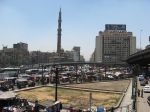

In March, 2016 the Egyptian Railway Museum reopened.
Photo Gallery of the renovated museum.
Nearly three years ago, during May 2013, while visiting Cairo, I planned to see the Egyptian Railway Museum which occupies a portion of Ramses Station on the edge of a vast area of traffic flyovers, market stalls and vehicle congestion.


A colossal statue of Ramses in the busy plaza is a visual landmark if you arrive by taxi.

At the time I visited, an antique locomotive, part of the Egyptian rail network built by Scotsman Robert Stephenson, was displayed in front of the train station. The Stephenson family produced notable civil engineers, designers of railroads and bridges. The other Stevenson family — of writer Robert Louis Stevenson — were lighthouse designers and engineers.
Signs in the plaza pointed to the museum inside the station. As I walked closer, I saw the railway museum was in a state of deplorable ruin with massive piles of rubble outside, windows broken out, and an abandoned dozer tilting on piles of broken stones and tile. The museum building was a wrecked shell. Was a renovation project placed on hold because of the disruption caused by deep-seated unrest back in early 2011? Or was the building destroyed as a byproduct of cultural editing and property destruction undertaken during the “Year of Morsi” ? I could only wonder.
Fast forward a few years. A follower of this blog named Davy posted a comment with the photos of the reopened museum. I haven’t had the opportunity to return to Cairo since 2013, but the freshly opened railway museum offers an incentive.




The world’s first national rail networks began in Britain, with the inter-city line connecting industrial midland Manchester with the port of Liverpool in 1830.
Egypt forged a national rail network next. France had short rail lines in place, but not an network that could move goods long distance overland. Egypt’s rail system connected ports on the Indian Ocean to the Mediterranean Sea until the Suez Canal was opened in 1869.
Egypt’s initial railway track was built between Cairo and Alexandria. By 1856-1858, Egypt had a functioning railway network, which fitted the British interest in keeping the region stable and to secure faster communications and transport routes to India, the crown jewel of British colonial resources.
Britain tended to support the Ottoman Empire (which in theory ruled Egypt at the time) against all challengers, while British merchants nosed out commercial opportunities in the Nile Valley and Suez. An overland route opened between the port of Alexandria and the Gulf of Suez and the rolling stock and engine designed by Stephenson improved the route.






